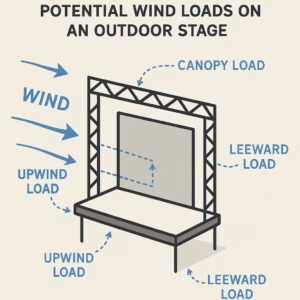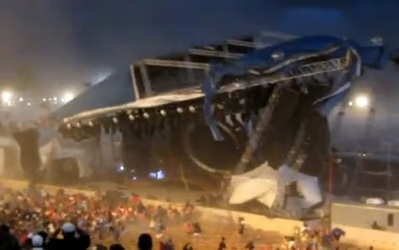This is the first of a series of articles on outdoor stages and the safety and compliance issues involved with their use.
Outdoor concert and festival stages present safety challenges that far exceed those in fixed venues. While arenas and theaters benefit from permanent infrastructure, climate control, and integrated systems for power, fire protection, and evacuation, outdoor events must operate on temporary foundations — often in open fields, fairgrounds, or parks. These stages depend on temporary rigging, ballast, and electrical systems that are installed, tested, and dismantled within days. When rushed, under-engineered, or exposed to extreme weather, these setups can become catastrophic.
For festival organizers and event promoters, understanding these risks is more than a regulatory formality — it’s an operational imperative. Outdoor stage safety depends on the coordination between production managers, engineers, insurers, and safety officers. When any one of those links breaks, lives and reputations are on the line.
TSE Entertainment, with decades of experience managing concerts, festivals, and live events nationwide, has seen firsthand how small oversights in planning, engineering, or weather monitoring can turn into major incidents. This article breaks down the most common safety risks in outdoor staging — and how to mitigate them through engineering diligence, proactive management, and trusted stage provider vetting.
Weather: The Uncontrollable Variable in Stage Safety
Weather hazards remain the leading cause of outdoor stage failures. High winds, lightning, heavy rain, and heat each introduce distinct threats that can undermine structural stability or endanger crews and attendees.
At just 40 mph, wind can exert about 10 pounds per square foot of lateral force. On a large LED wall or roof canopy, this translates into tens of thousands of pounds of pressure. In 2011, the Indiana State Fair stage collapse tragically demonstrated how inadequate ballast and unclear weather authority can have fatal results when gusts hit 59 mph.
Event producers often ask, “At what wind speed should we suspend or evacuate an outdoor event?” The industry standard today is to begin load reduction at 25–30 mph and evacuate at 40–50 mph. Having a clear weather action plan, with an empowered safety officer authorized to stop a show, is no longer optional — it’s essential.
Rain can weaken soil that supports ballast, while lightning poses obvious threats to stages that act as tall, conductive structures. Following NFPA 780 grounding standards and implementing lightning detection systems should be standard practice. Even heat presents risks: metal decks can exceed 120°F, creating safety concerns for crew members during setup and teardown.
TSE Entertainment incorporates real-time weather monitoring and emergency communication protocols into every event plan — ensuring site safety decisions are made swiftly and confidently when conditions change.
Outdoor Stage Structural Stability: Engineering Under Pressure

When live loads, rigging loads, and environmental loads combine, the cumulative stress can exceed design limits — especially when unplanned additions like extra lighting or video screens are introduced after the engineering review. A stage designed to support 50,000 lbs. of static load may face 65,000 lbs. or more under wind gusts, leading to catastrophic failure.
Most collapses trace back to ballast failure. Inadequate weight, uneven soil, or improperly strapped blocks can shift under stress. A single ballast block that slides or sinks changes the geometry of the entire structure, weakening its resistance to wind.
When TSE Entertainment manages events, it partners only with vetted stage and structure providers whose systems meet or exceed ANSI E1.21 standards and carry PE-stamped engineering documentation. Before any installing any outdoor stage, if necessary, TSE coordinates soil inspections, ballast verification, and independent load review to ensure structural compliance — even under dynamic festival conditions.
Rigging Hazards: Hidden Dangers Above An Outdoor Stage
Few hazards are as deadly as rigging failures. Speakers, lighting trusses, and LED walls are suspended directly above performers, crew, and audiences. These loads are not static — they move with wind, vibration, and mechanical motion. A dynamic rigging load can double the stress on hoists and truss systems compared to static weights.
Festival organizers often ask, “How much wind can a hung LED wall withstand before it becomes unsafe?” The answer depends on engineering specifics, but as a rule, any flown element should have a wind-release mechanism or demounting plan once gusts exceed 25 mph.
Many incidents, such as the Toronto stage collapse (2012) and the Brazil LED wall collapse (2012), were traced back to unbalanced rigging loads and sail effects that exceeded design limits. Misuse of chain hoists, uneven load distribution, and last-minute production changes frequently lead to overloads.
To prevent these failures, TSE Entertainment requires detailed engineered rigging plots, manufacturer load certifications, and on-site verification by competent riggers for major custom built stages. These safeguards ensure all suspended equipment remains within safe limits — even under stress.
Electrical Hazards and Power Distribution Risks with Outdoor Staging
Outdoor events rely on portable power systems — and electrical safety is one of the most underestimated hazards in live production. Poor grounding, damaged cabling, or improper generator placement can lead to electric shock, fire, or arc flash incidents.
A grounding resistance above 25 ohms may leave metal components energized, turning trusses or railings into live conductors. Proper bonding, verified with a resistance test, is critical. The National Electrical Code (Article 525) outlines grounding, bonding, and weatherproofing requirements that all temporary event power systems must meet.
Fuel management is another concern. Generators must be positioned at least 20 feet from stages and fuel at least 50 feet from stages and away from public areas. Wind can carry exhaust toward crew areas, leading to carbon monoxide exposure, or ignite leaking fuel if wiring faults occur. Cable runs should be protected where they cross pedestrian areas to prevent insulation wear or trip hazards.
At TSE Entertainment, electrical safety isn’t an afterthought. Stage contractors are required to use e licensed electricians, weatherproof connectors, and redundant ground testing. These precautions protect both personnel and equipment, ensuring uninterrupted show operation and compliance with NEC and local AHJ standards.
Crowd Safety and Emergency Management Needs
Even when the stage structure is sound, crowd management remains a critical component of overall event safety. Inadequate egress routes, poor signage, or obstructed exits can cause deadly surges during panic situations.
Tragedies such as the Roskilde Festival (2000) and Love Parade (2010) underscore that crowd density and flow are as important as truss stability or ballast weight. The International Building Code (IBC) mandates exit widths based on occupant load — typically 0.2 inches per person. When applied to large events, that can translate to 20 feet or more of required exit width for a single backstage area.
Festival organizers often wonder, “How long would it take to evacuate our audience in a storm?” Evacuation modeling shows that even a 20,000-person audience may require over 30 minutes to clear, while dangerous weather can arrive in under 10.
TSE Entertainment’s event management team works with festival organizers to integrate crowd flow modeling, ADA accessibility compliance, and emergency action planning into every festival design, ensuring attendees can exit safely and efficiently in any scenario.
The Interconnected Nature of Outdoor Stage Risks

Stage collapses and safety failures rarely stem from one factor alone. Weather, rigging, ballast, electrical systems, and
crowd behavior all interact. The Indiana State Fair tragedy showed how high winds, inadequate ballast, unclear communication, and delayed evacuation combined into a single chain of failure.
That’s why successful outdoor event management requires an integrated safety strategy. At TSE Entertainment, that integration happens from the first site plan to the final teardown — with coordination among engineers, insurance providers, safety officers, and production crews for major events.
Insurance, Compliance, and Accountability
Insurance providers have evolved from passive underwriters to active risk partners. Today, most will not issue coverage without documentation of compliance. Requirements typically include engineered drawings, weather action plans, inspection logs, and evacuation authority designations. Claims have been denied for falsified certifications, non-UL cables, and overloaded rigging — all preventable failures.
TSE Entertainment works directly with event organizers to ensure that every outdoor stage, lighting system, and generator meets compliance standards before event day. This proactive approach not only protects against liability but strengthens credibility with sponsors, artists, and regulators.
Building Safer Festivals
The safety of an outdoor stage depends on more than engineering — it relies on accountability, coordination, and expertise. For festival organizers and event promoters, this means prioritizing certified structures, trained crews, documented inspections, and enforceable safety authority.
TSE Entertainment’s team of event professionals brings decades of experience in concert production, festival management, and stage provider vetting. From engineering reviews to weather response planning, TSE ensures every outdoor production is built, operated, and dismantled with safety and compliance at its core.
Partner with TSE for Safer Outdoor Events
Don’t leave safety to chance. Whether you’re planning a regional festival, a corporate concert, or a national tour, TSE Entertainment provides comprehensive support — from event management and technical production to vetting stage providers, reviewing engineering documentation, and coordinating compliance with AHJs and insurers.
Work with a partner that understands both the artistry and the accountability behind live events.
Contact TSE Entertainment today to build your next outdoor event on a foundation of safety, integrity, and peace of mind.
Related Post: Choosing the Right Stage for My Event
People Also Ask
What causes outdoor stage collapses?
Most stage collapses result from a combination of wind, insufficient ballast, overloaded rigging, and delayed weather response.
How do event organizers ensure stage safety?
By hiring qualified engineers, implementing weather action plans, inspecting ballast and rigging daily, and following ANSI E1.21 and IBC standards.
At what wind speed should an outdoor concert stop?
Most safety plans call for load reduction at 25–30 mph and full evacuation at 40–50 mph winds.
What safety standards apply to outdoor stages?
ANSI E1.21, NFPA 780, NEC Article 525, and the International Building Code are key references for U.S. outdoor event safety.


